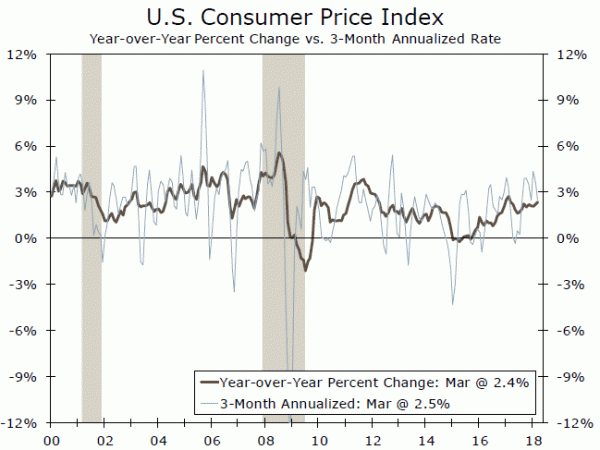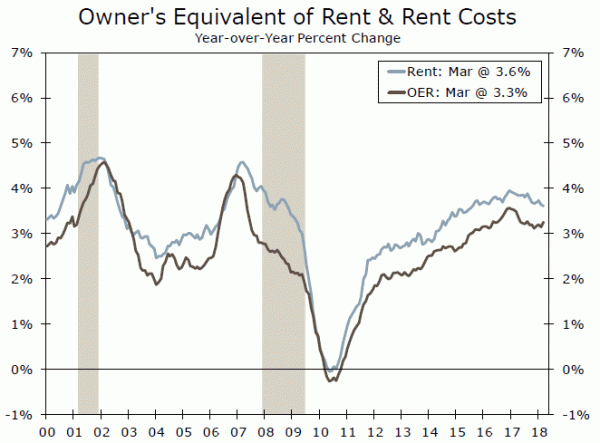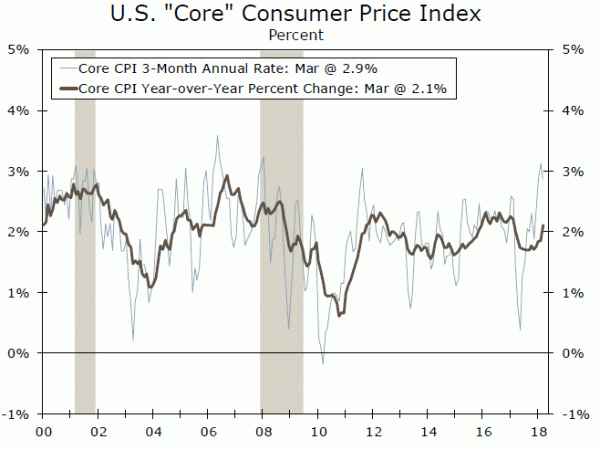The Consumer Price Index fell 0.1 percent in March amid a drop in gasoline prices. The trend is firming, however, with the core index increasing 0.2 percent and at a 2.9 percent annual rate over the past three months.
Energy Burns Consumer Price Inflation in March
CPI inflation fell 0.1 percent in March, the first monthly decline in a year. March’s decline can be entirely traced to energy, where prices fell 2.8 percent. The cost of energy services dipped slightly last month, but the primary source of the pullback was a 4.9 percent drop in gasoline prices. Elsewhere, however, price gains were stronger and point to inflation continuing to firm. Prices for food at home rose 0.1 percent, which was above the average monthly gain over the past year.
Core Remains Strong
After what had been the strongest three-month run in 10 years, the core index increased 0.2 percent (0.18 percent). Although on the surface the gain looked similar to February, when the index also rose 0.18 percent, the components tell a different story.
Core services strengthened 0.3 percent, led by a rebound in shelter costs. Primary rent and owners’ equivalent rent last month posted the smallest gains in more than three years, so the 0.4 percent increase in shelter costs looks due to some payback for last month’s below-trend reading. It is worth noting, however, that rent growth has been slowing more generally, leading to the smallest 12-month gain since late 2015 as the flood of new apartments is finally beginning to weigh on prices. Prices for medical services also strengthened notably (up 0.5 percent) after being flat last month.
Snapping a three-month string of gains, core goods prices edged down 0.1 percent. Apparel prices led the decline (down 0.6 percent) after what had been the strongest two months of increases since the early 1990s. Used vehicle prices fell for a second straight month, down 0.3 percent.
Wireless Services No Longer a Hang Up
It was this time last year that core inflation posted a surprising decline due to the now-infamous drop in wireless services. The index fell 0.1 percent—a rare event outside of a recession. With the drop now a full year behind us, the 12-month rate of core inflation jumped from 1.8 percent to 2.1 percent. While the 12-month change has been helped by an easy base comparison, we believe there is more strength to come even without such a favorable comparison over the next few months. Core CPI has increased at a 2.9 percent annual rate over the past three months, which points to the year-ago rate of core CPI climbing a bit further in the months to come. We look for the core index to increase 2.2 percent year-over-year in the second quarter.
FOMC Chair Powell and other members have been aware of the favorable arithmetic surrounding the year-ago rate of core inflation, so the jump in March is unlikely to alter their view of inflation. What we believe is likely to be more influential in the Fed’s thinking is the strength that has prevailed since late last year, as well as broadening indications of higher input costs for labor and raw materials.















